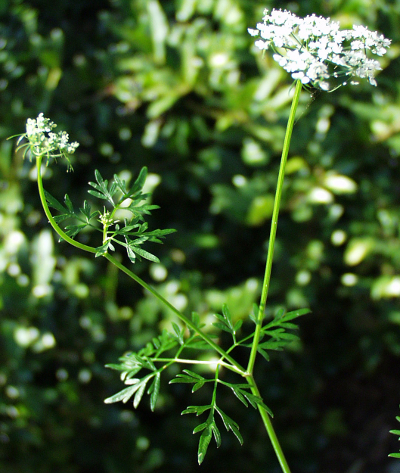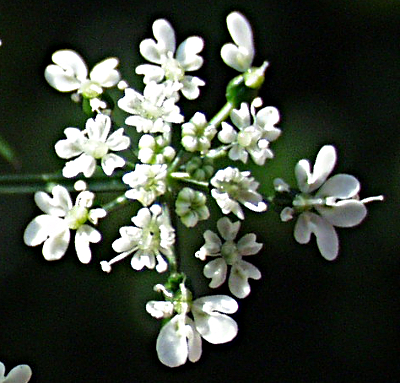Aethusa |

The fool's parsley is the only species in the genus

Flowers of the fool's parsley (Aethusa cynapium)
Possible confusion with parsley
The fool's parsley is highly toxic and when young easily confused with flat-leaf parsley, especially if it grows between real parsley. Poisonings were not uncommon in the past, so we bred to curly parsley. In contrast to the aromatic fragrant parsley Aethusa cynapium has an unpleasant odor when crushed. The undersides of the leaves of the fool's parsley shines – that of the parsley is dull. Moreover fool's parsley blooms with white flowers, while parsley blooms yellow. From other white flowering Apiaceae they can be distinguished by the usually 3 rather long lanceolate raylet leaves, which are only formed on the outside of the umbellules and which point diagonally down.
| Floral formula: |
| *–↓ K5 C5 A5 G(2) inferior |
Toxins
The toxins contained in the plant called coniine and aethusin. Coniine also occurs in hemlock and is responsible for the unpleasant odor that is often compared to the urine of mice. The poison became admits through the cup of hemlock of Sokrates.
Coniine has structural similarities with acetylcholine, a neurotransmitter, and occupies its receptors in the postsynaptic membrane of the muscle fiber. However, this does not open the ion channels, such as with acetylcholine. It is therefore triggered no action potential, which can contract the muscle fiber, but by the blockade of the receptor, the binding of acetylcholine is prevented whereby the muscle is paralyzed. Death occurs by paralysis of the diaphragm muscles.
Aethusin is closely related with the toxin of the cowbane and is mainly found in the roots. It binds to certain receptors (GABAA) of the neurotransmitter γ-aminobutyric acid in the central nervous system. Usually are opened by the binding of the ligand chloride channels, resulting in hyperpolarization of the nerve cell, so that the excitation threshold is increased. Aethusin blocks the receptors without opening the ion channels and prevents the binding of γ-aminobutyric acid, so that the excitation threshold is reduced, so that smallest stimuli may cause to muscular cramps. The spasms can lead to cardiac and respiratory arrest.
Meaning of the species names
- cynapium: gr. Kynos = of dogs, lat. Apium = celery ("dog celery")
- elata: lat. elatus = high
Interesting notes
Among the celery family only hemlock, cowbane and water dropwort are more toxic than the fool's parsley.
The fool's parsley is used in homeopathy, a controversial system of healing, to help amongst others against cramps and diarrhea and vomiting.